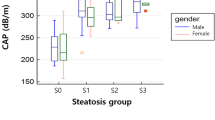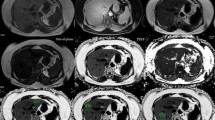Abstract
Objective
To identify controlled attenuation parameter (CAP) based cutoffs for diagnosing and grading hepatic steatosis in adolescents with overweight/obesity, using magnetic resonance imaging-proton density fat fraction (MRI-PDFF) as the reference method.
Methods
Adolescents with overweight/obesity were included. Fasting glucose, insulin, aspartate aminotransferase, and alanine aminotransferase were estimated. Hepatic steatosis (S) was assessed by MRI-PDFF, and graded as S0, S1, S2, and S3 with fat fraction cutoffs of < 6.0%, ≥ 6.0% to < 17.5%, ≥ 17.5% to < 23.3%, and ≥ 23.3%, respectively. CAP and liver stiffness measure (LSM) were assessed using FibroScan. Receiver operating characteristic (ROC) curves were used to estimate the CAP scores predicting various grades of hepatic steatosis.
Results
A total of 108 adolescents aged 12.4 ± 1.9 y, with mean BMI of 26.7 ± 4.9 kg/m2 were included. S0, S1, S2, and S3 steatosis by MRI-PDFF was identified in 15, 70, 13, and 10 adolescents, respectively. A moderate positive correlation was observed between CAP score and MRI-estimated hepatic fat (r = 0.528, p < 0.001). The optimal CAP cutoffs for identifying ≥ S1, ≥ S2, and S3 steatosis were 271 [area under ROC (AUROC) 0.745 (0.630–0.859)], 296 [AUROC 0.820 (0.728–0.911)], and 309 dB/m [AUROC 0.836 (0.729–0.944)], respectively.
Conclusion
CAP score had a good discriminative ability to diagnose fatty liver in adolescents with overweight or obesity.


Similar content being viewed by others
References
Kohli R, Sunduram S, Mouzaki M, et al. Pediatric nonalcoholic fatty liver disease: a report from the expert committee on nonalcoholic fatty liver disease (ECON). J Pediatr. 2016;172:9–13.
Schwimmer JB, Deutsch R, Kahen T, Lavine JE, Stanley C, Behling C. Prevalence of fatty liver in children and adolescents. Pediatrics. 2006;118:1388–93.
Anderson EL, Howe LD, Jones HE, Higgins JPT, Lawlor DA, Fraser A. The prevalence of non-alcoholic fatty liver disease in children and adolescents: a systematic review and meta-analysis. PLoS One. 2015;10:e0140908.
Xanthakos SA, Jenkins TM, Kleiner DE, et al. High prevalence of nonalcoholic fatty liver disease in adolescents undergoing bariatric surgery. Gastroenterology. 2015;149:623–34.
Hoque ME, Doi SAR, Mannan M, Long K, Niessen LW, Mamun AA. Prevalence of overweight and obesity among children and adolescents of the Indian subcontinent: a meta-analysis. Nutr Rev. 2014;72:541–50.
Jain V, Jana M, Upadhyay B, et al. Prevalence, clinical & biochemical correlates of non-alcoholic fatty liver disease in overweight adolescents. Indian J Med Res. 2018;148:291–301.
Goyal NP, Schwimmer JB. the progression and natural history of pediatric nonalcoholic fatty liver disease. Clin Liver Dis. 2016;20:325–38.
A-Kader HH, Henderson J, Vanhoesen K, Ghishan F, Bhattacharyya A. Nonalcoholic fatty liver disease in children: a single center experience. Clin Gastroenterol Hepatol. 2008;6:799–802.
Chalasani N, Younossi Z, Lavine JE, et al. The diagnosis and management of nonalcoholic fatty liver disease: Practice guidance from the American association for the study of liver diseases. Hepatology. 2018;67:328–57.
Ciet P, Tiddens HAWM, Wielopolski PA, et al. Magnetic resonance imaging in children: common problems and possible solutions for lung and airways imaging. Pediatr Radiol. 2015;45:1901–15.
Netaji A, Jain V, Gupta AK, Kumar U, Jana M. Utility of MR proton density fat fraction and its correlation with ultrasonography and biochemical markers in nonalcoholic fatty liver disease in overweight adolescents. J Pediatr Endocrinol Metab. 2020;33:473–9.
Dyson JK, Anstee QM, McPherson S. Non-alcoholic fatty liver disease: a practical approach to diagnosis and staging. Frontline Gastroenterol. 2014;5:211–8.
Pu K, Wang Y, Bai S, et al. Diagnostic accuracy of controlled attenuation parameter (CAP) as a non-invasive test for steatosis in suspected non-alcoholic fatty liver disease: a systematic review and meta-analysis. BMC Gastroenterol. 2019;19:51.
Shah J, Okubote T, Alkhouri N. Overview of Updated practice guidelines for pediatric nonalcoholic fatty liver disease. Gastroenterol Hepatol (N Y). 2018;14:407–14.
Khadilkar V, Yadav S, Agrawal KK, et al. Revised IAP growth charts for height, weight and body mass index for 5- to 18-year-old Indian children. Indian Pediatr. 2015;52:47–55.
Rout G, Kedia S, Nayak B, et al. Controlled attenuation parameter for assessment of hepatic steatosis in indian patients. J Clin Exp Hepatol. 2019;9:13–21.
Shin J, Kim MJ, Shin HJ, et al. Quick assessment with controlled attenuation parameter for hepatic steatosis in children based on MRI-PDFF as the gold standard. BMC Pediatr. 2019;19:112.
Tang A, Tan J, Sun M, et al. Nonalcoholic fatty liver disease: mr imaging of liver proton density fat fraction to assess hepatic steatosis. Radiology. 2013;267:422–31.
van Werven JR, Marsman HA, Nederveen AJ, et al. Assessment of hepatic steatosis in patients undergoing liver resection: comparison of US, CT, T1-weighted Dual-Echo MR Imaging, and point-resolved 1 H MR Spectroscopy. Radiology. 2010;256:159–68.
Schwimmer JB, Middleton MS, Behling C, et al. Magnetic resonance imaging and liver histology as biomarkers of hepatic steatosis in children with nonalcoholic fatty liver disease: clinical observations in hepatology. Hepatology. 2015;61:1887–95.
Davison BA, Harrison SA, Cotter G, et al. Suboptimal reliability of liver biopsy evaluation has implications for randomized clinical trials. J Hepatol. 2020;73:1322–32.
Ferraioli G, Calcaterra V, Lissandrin R, et al. Noninvasive assessment of liver steatosis in children: the clinical value of controlled attenuation parameter. BMC Gastroenterol. 2017;17:61.
Desai NK, Harney S, Raza R, et al. Comparison of controlled attenuation parameter and liver biopsy to assess hepatic steatosis in pediatric patients. J Pediatr. 2016;173:160–4.
Runge JH, van Giessen J, Draijer LG, et al. Accuracy of controlled attenuation parameter compared with ultrasound for detecting hepatic steatosis in children with severe obesity. Eur Radiol. 2021;31:1588–96.
Shalimar, Kumar R, Rout G, et al. Body mass index–based controlled attenuation parameter cut-offs for assessment of hepatic steatosis in non-alcoholic fatty liver disease. Indian J Gastroenterol. 2020;39:32–41.
Karlas T, Petroff D, Sasso M, et al. Individual patient data meta-analysis of controlled attenuation parameter (CAP) technology for assessing steatosis. J Hepatol. 2017;66:1022–30.
Imajo K, Kessoku T, Honda Y, et al. Magnetic resonance imaging more accurately classifies steatosis and fibrosis in patients with nonalcoholic fatty liver disease than transient elastography. Gastroenterology. 2016;150:626-37.
Caussy C, Alquiraish MH, Nguyen P, et al. Optimal threshold of controlled attenuation parameter with MRI-PDFF as the gold standard for the detection of hepatic steatosis. Hepatology. 2018;67:1348–59.
Caussy C, Brissot J, Singh S, et al. Prospective, same-day, direct comparison of controlled attenuation parameter with the M vs the XL probe in patients with nonalcoholic fatty liver disease, using magnetic resonance imaging–proton density fat fraction as the standard. Clin Gastroenterol Hepatol. 2020;18:1842–50.
Oeda S, Tanaka K, Oshima A, Matsumoto Y, Sueoka E, Takahashi H. Diagnostic accuracy of fibroscan and factors affecting measurements. Diagnostics (Basel). 2020;10:940.
Lee H, Jun DW, Kang BK, et al. Estimating of hepatic fat amount using MRI proton density fat fraction in a real practice setting. Medicine (Baltimore). 2017;96:e7778.
Funding
This work was supported under a National Task Force project by Indian Council of Medical Research, New Delhi (Grant ID No. 5/4/3–2-2017-NCD-II, to VJ).
Author information
Authors and Affiliations
Contributions
AA: Manuscript writing, revision, statistical analysis; S: Manuscript writing, study concept; MJ, DK, BK, and GS: Data collection; VJ: Study concept, design, manuscript writing and revision. VJ is the guarantor of this paper.
Corresponding author
Ethics declarations
Ethics Committee Approval
Study was conducted after approval from the Ethics Committee of All India Institute of Medical Sciences, New Delhi.
Informed Consent
Written voluntary informed consent was taken from parents and assent from the adolescents.
Conflict of Interest
None.
Additional information
Publisher's Note
Springer Nature remains neutral with regard to jurisdictional claims in published maps and institutional affiliations.
Supplementary Information
Below is the link to the electronic supplementary material.
12098_2021_3842_MOESM1_ESM.tiff
Supplementary file1: Supplementary Fig. S1 (a) Scatter plots showing a moderate positive correlation between CAP and MRI-PDFF (r = 0.528, p < 0.001). (b) Scatter-plots showing a weak positive correlation between body fat percentage and CAP (r = 0.308, p = 0.003) (TIFF 116 KB)
Rights and permissions
About this article
Cite this article
Anand, A., Shalimar, Jana, M. et al. Usefulness of Controlled Attenuation Parameter for Identification and Grading of Nonalcoholic Fatty Liver Disease in Adolescents with Obesity. Indian J Pediatr 89, 52–58 (2022). https://doi.org/10.1007/s12098-021-03842-1
Received:
Accepted:
Published:
Issue Date:
DOI: https://doi.org/10.1007/s12098-021-03842-1




